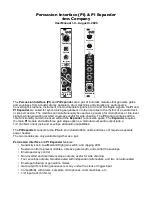
Envelopes in Follow Mode
Using the
PI
in
Follow
mode allows the envelope to directly
follow the amplitude variations of the input signal. The
velocity of the input signal can be imparted onto the output
envelopes. The envelope shape can be more complex than
the sustain-decay envelope of
Gen.
mode. In
Follow
mode,
the envelope and
Gate
outputs can fire at different times.
Figures 3
and
4
use a similar input signal as
Figures 1
and
2
in the previous section. Notice that the envelopes
(represented by the blue waveform on the bottom) are not
uniform. Also notice that the shape of the envelope
correlates more strongly to the contours of the input source
(represented by red waveform at the top) as opposed to
the gate (represented by the orange waveform in the
middle). The amplitude of the input source directly influences the envelope’s maximum
voltage, allowing for more organic envelope shapes and
introducing some variability into the CV output.
In
Follow
mode the
Decay
knob controls how quickly the
envelope decays when the input amplitude falls. The
envelope attack is always very rapid.
Figure 5
illustrates
the envelope shape when
Decay
is set fully
counterclockwise
.
You’ll notice the envelope begins to
resemble the input source more closely. This can be used
as an audio output, as a frequency modulation source, or
in other creative ways.
In
Follow
mode, the
PI
envelopes are sensitive to the
velocity of the input source and therefore produce a greater
variety of envelope shapes. Because envelopes generated in
Follow
mode follow the
amplitude of the input signal, louder sounds result in higher
voltage envelopes, and quieter sounds result in lower
voltage envelopes.
Figure 6
shows two waveforms: the
envelope output in blue, and the input signal in red. The
Decay
knob is set very low in this example. The input
signal consists of a bass drum hit followed by a high-hat
hit. Notice the bass drum hit causes a relatively high
voltage envelope, while the high hat produces a lower
voltage envelope. See the Velocity Sensing
section
below
for more information.
Page of
9
16
Figure 3
Figure 4
Figure 5
Figure 6


































